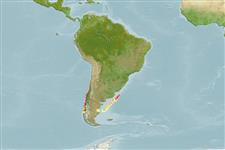Klassifizierung / Names
Namen | Synonyme | Catalog of Fishes(Gattung, Arten) | ITIS | CoL | WoRMS | Cloffa
>
Gadiformes (Cods) >
Macrouridae (Grenadiers or rattails)
Etymology: Coelorinchus: Greek, koilos = a hollow + Greek, rhyngchos = jaw (Ref. 45335).
More on author: Iwamoto.
Environment: milieu / climate zone / depth range / distribution range
Ökologie
seewasser benthopelagisch; standorttreu; tiefenbereich 119 - 450 m (Ref. 1371). Subtropical; 30°S - 56°S, 80°W - 54°W (Ref. 1371)
Southeast Pacific and Southwest Atlantic: Chile (up to 41°S) and Argentine Patagonia.
Size / Gewicht / Alter
Maturity: Lm ? range ? - ? cm
Max length : 39.0 cm TL Männchen/unbestimmt; (Ref. 1371)
Rückenflossenstacheln (insgesamt) : 0; Afterflossenstacheln: 0. Head large; eyes large; snout short and bluntly pointed. Body elongated, tapering abruptly from the first dorsal-fin base. Light organ rather short, extending in front of the anus within the body wall as a flattened, elongate diverticulum falling well short of the pelvic fin bases. Scales rather large and deciduous. Color is brownish to swarthy; the trunk bluish to violet; the fins dusky to blackish. A prominent blackish area behind the pectoral fin bases. The mouth and gill cavities pale.
Feeds on copepods, pagurid and brachyurid crabs, and shrimp-like crustaceans.
Life cycle and mating behavior
Maturities | Fortpflanzung | Spawnings | Egg(s) | Fecundities | Larven
Cohen, D.M., T. Inada, T. Iwamoto and N. Scialabba, 1990. FAO species catalogue. Vol. 10. Gadiform fishes of the world (Order Gadiformes). An annotated and illustrated catalogue of cods, hakes, grenadiers and other gadiform fishes known to date. FAO Fish. Synop. 125(10). Rome: FAO. 442 p. (Ref. 1371)
IUCN Rote Liste Status (Ref. 130435)
Bedrohung für Menschen
Harmless
Nutzung durch Menschen
Fischereien: weniger kommerziell
Tools
Zusatzinformationen
Download XML
Internet Quellen
Estimates based on models
Preferred temperature (Ref.
123201): 7 - 10.5, mean 9.5 °C (based on 12 cells).
Phylogenetic diversity index (Ref.
82804): PD
50 = 0.5000 [Uniqueness, from 0.5 = low to 2.0 = high].
Bayesian length-weight: a=0.00251 (0.00128 - 0.00492), b=3.19 (3.03 - 3.35), in cm total length, based on LWR estimates for this Genus-body shape (Ref.
93245).
Trophic level (Ref.
69278): 3.4 ±0.49 se; based on food items.
Widerstandsfähigkeit (Ref.
120179): niedrig, Verdopplung der Population dauert 4,5 - 14 Jahre. (Preliminary K or Fecundity.).
Fishing Vulnerability (Ref.
59153): Low to moderate vulnerability (29 of 100).
Nutrients (Ref.
124155): Calcium = 57 [28, 117] mg/100g; Iron = 0.779 [0.420, 1.388] mg/100g; Protein = 16.6 [14.4, 19.0] %; Omega3 = 0.228 [0.112, 0.422] g/100g; Selenium = 44.1 [19.5, 91.3] μg/100g; VitaminA = 19.6 [5.3, 72.9] μg/100g; Zinc = 0.869 [0.588, 1.313] mg/100g (wet weight);
